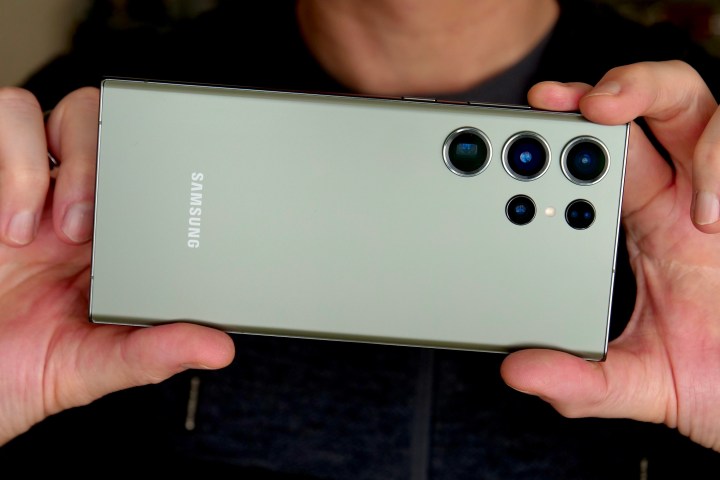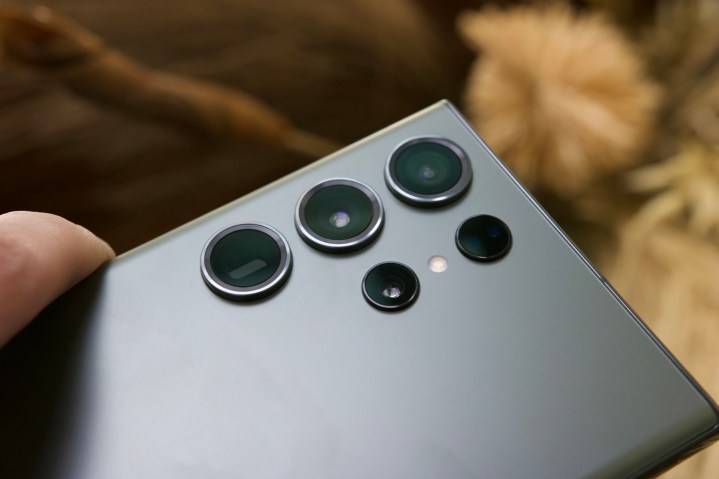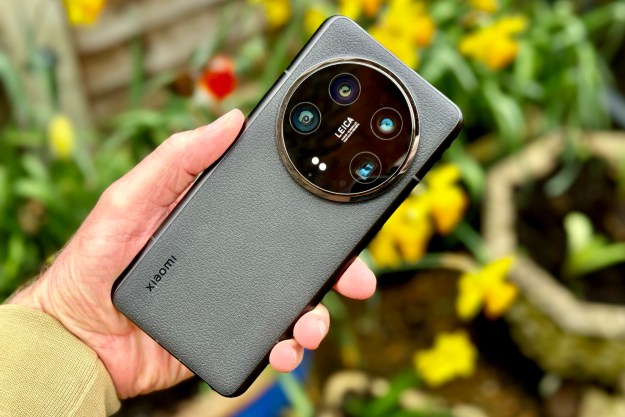It’s no secret that the Samsung Galaxy S23 Ultra is an amazing camera phone. It thoroughly impressed me in my full review of the device, and it handily beat Google’s best in our Galaxy S23 Ultra vs. Pixel 7 Pro camera test. But that was all focused on using the S23 Ultra’s camera for still photos. Is it any good for video recording?
It’s a question I wanted an answer to, but looking around online, hardly anyone is giving the S23 Ultra’s video capabilities the same treatment as its still photo performance. And I wanted to change that. After spending two days on the Isle of Wight off the south coast of the U.K. and staying in the historic Arreton Manor, I recorded more video with the Galaxy S23 Ultra than I have with any phone in years. At the end of this experiment, I can’t believe what happened.
Video specifications

The Galaxy S23 Ultra takes video using the same cameras as you use when taking still photographs, so expect to take wide-angle, 3x, and 10x optical zoom video in normal mode. You can shoot in 1080p at 30 frames per second (fps) or 60 fps, at 4K resolution video (3840 x 2160 pixels) at 60 fps and in HDR10+, and at 8K resolution (a massive 7680 x 4320 pixels) at 24 fps or 30 fps. I shot mostly in 4K at 60 fps, but without HDR10+.
There are several slow-motion modes too. The standard shoots in 1080p at 240 fps, while the Super Slow-motion is the same 1080p resolution, but at 960 fps. The Hyperlapse mode shoots in 4K at 30 fps, and Portrait Video mode is also in

Why didn’t I use the HDR10+ mode? The feature has to be manually activated, but the videos save in HVEC format, which can limit compatibility. To make it easier to show you the results of the test, videos were shot and saved as H.264 videos. How about storage space? On average, one minute of 4K, 60 fps video takes up a substantial 400MB.
Internal storage, and your demands on it, are definitely something to think about before buying your phone. If you want to shoot and keep a lot of video, investing in as much internal storage space as you can afford will be wise. Over two days, I shot 60 individual videos — most around 30 seconds to a minute long — plus a couple of five-minute videos. Once all was said and done, it took up nearly 10GB.
Recording video with the Galaxy S23 Ultra
A big part of the Galaxy S23 Ultra’s appeal is its three (or four, depending on how you look at it) different camera modes — main, wide-angle, 3x, and 10x zoom — all of which can also be utilized when taking video. You can switch between each mode while shooting and there’s no need to stop and change the camera. This was something I wanted to explore during my time with the phone.
It’s as simple to do as it is when taking stills — just tap the requisite button in the viewfinder, and you can move between each camera. There are masses of versatility, allowing you to show off an entire scene and capture both scale and detail, all in the same video. While it takes just moments to switch between them, the transition isn’t that seamless. The camera takes a second to adjust to the new lens, and there’s a second where the color, exposure, or focus looks “off” right after you switch to another camera.
Where the S23 Ultra excels is when shooting video at 10x zoom.
This can be distracting and is not as noticeable when switching between cameras on the iPhone 14 Pro. Where the S23 Ultra excels is when shooting video at 10x zoom, which looks just as crisp and detailed as it does when shooting at 3x or 1x. The iPhone 14 Pro can manage a 3x optical, or 9x digital zoom shooting 4K resolution video, when the result looks noisy and obviously digitally enhanced.
You can digitally zoom in to 20x on the S23 Ultra when taking 4K video, but like the iPhone 14 Pro’s 9x mode, it’s noisy and not particularly attractive, so it’s best avoided. Just like it is with the stills camera, the 10x zoom is a huge selling point when it comes to shooting video, and the camera’s versatility beats all other flagship phones available at the moment.
Unfortunately, the weather wasn’t great during my test, so none of my videos managed to really show off the camera’s ability to capture color. What they did show is how the S23 Ultra effectively captures the natural atmosphere. The shots in the garden, early in the morning with the grass and bushes covered in a fine mist of rain, look almost exactly how they did in real life. The wide-angle camera does accentuate colors a little more than the main camera, while the 10x zoom isn’t as vibrant as either of them.
Lowlight video and stabilization
Taking video in darkness with only minimal ambient light, the Galaxy S23 Ultra brightens the scene considerably, but it’s not always to the video’s benefit. Darker areas become noisy, and colors are influenced by the camera’s decision to dramatically brighten the scene, so they become less realistic. You can definitely see plenty, but even with the excellent stabilization, detail blurs when moving around, and the scene loses atmosphere.
Interestingly, the iPhone 14 Pro takes a very different approach, barely brightening the scene at all, but it makes for a more stable, less blurry, and far more realistic look. The iPhone’s superb white balance is evident throughout all the comparisons with the Galaxy S23 Ultra, which is never quite as precise, but it’s particularly noticeable in extreme lowlight conditions.
When you’re standing still, the Galaxy S23 Ultra provides an impressive amount of stabilization — even at 10x zoom — making it very easy to keep your subject in the viewfinder. Unfortunately, it doesn’t always translate into the actual recorded video, with some 10x zoom shots showing more movement than expected. Come out to a 3x, 1x, or 0.6x wide angle, and no such issues occur. Most of the time, the small amount of added wobble won’t be a problem.
The Galaxy S23 Ultra provides an impressive amount of stabilization.
What about when you and the camera are moving around? I attached the Galaxy S23 Ultra to a window mount in a car, to see how much difference the Super Steady mode made to my recordings. Super Steady mode crops the image a lot, and it also affects the vibrancy of the image. The phone focused on the car’s interior rather than the outside, which is more of an issue caused by me doing the recording and driving on my own.
Focal issues aside, the stabilization is effective, as the car has relatively firm suspension, and the road surface wasn’t especially smooth. Videos where I’m moving were all shot at walking speed, sometimes with the phone attached to a large Joby GorillaPod, and you can see the video “jump” with my steps, but this mostly happened in poor lighting. Stabilization is generally very good, but you need the right conditions to get the best from it.
Galaxy S23 Ultra: slow-motion, Hyperlapse, and portrait video
Despite slow-motion video only being available in 1080p, and not having the zoom or wide-angle feature, I had fun with it. Everything I shot was smooth, and the effect looked excellent. The standard slow-motion mode can be used in most situations, as shown by the slow-motion videos of boats, which weren’t close to me. It means you can enjoy shooting slow-motion videos without waiting for exactly the right moment.
That’s not the case with the Super Slow-motion mode, which at 940 fps, practically brings everything to a standstill, so it specifically needs very fast-moving objects to be effective. Hyperlapse speeds everything up, with a five-minute recording generating a 20-second Hyperlapse video. The effect is fun, but the quality is quite dependent on how steadily you can hold the camera. Any shake or sudden movement is obvious and jarring in the end result.
Finally, Portrait Mode video adds various artificial bokeh-style effects to your video. Edge recognition is very good and adapts well to movement, but it requires a face to work best. The standard Slow Motion mode was my favorite additional feature (they are all hidden under the More menu in the camera app) and one I would often think about trying out to see what was captured. Happily, I found I liked the results.
The Galaxy S23 Ultra made me a video believer

Shooting video with the Galaxy S23 Ultra has been fun, and it does add another creative dimension to the already versatile stills camera. To really make your video stand out, you need to make the effort to edit and create a longer “movie.” Inside the Samsung Gallery app, there’s a handy Create Movie mode, where you can trim and string together different clips, then add transitions, titles, and music. It’s easy to use and makes the phone a one-stop shop for all things video.
The Galaxy S23 Ultra’s camera takes excellent photographs, and is far more versatile and creatively freeing than any other smartphone available today. Video shares the same features and versatility, and I really enjoyed the entire process of thinking differently, creating shots, looking for opportunities, and then editing videos together later. I missed just concentrating on stills, but this is probably more down to what I’m used to than anything to do with the phone.
It was only after editing the videos you can see in the article that something else crossed my mind. I think other, less well-equipped phones may have quickly sent me back to taking still photos, but it’s clear the Galaxy S23 Ultra’s many cameras and features make both photography and videography fun and enjoyable. It won’t be the last time I push myself to shoot video and not just take stills, and I have Samsung’s fantastic
Editors' Recommendations
- 5 phones you should buy instead of the Samsung Galaxy S24 Plus
- Samsung has a new (and cheaper) way to buy the Galaxy S23
- Having Galaxy S24 Ultra camera issues? A fix may be coming soon
- Have a Samsung Galaxy S23? Don’t update your phone to One UI 6.1
- Galaxy AI is now available for these other Samsung phones



